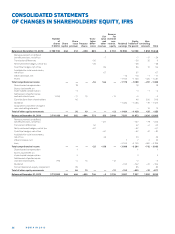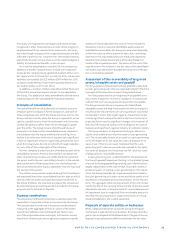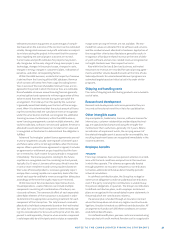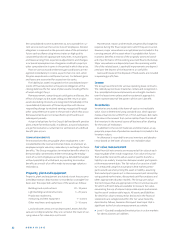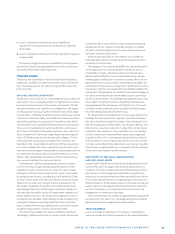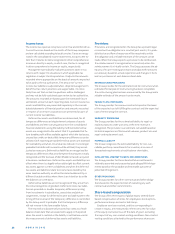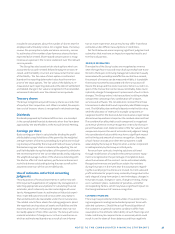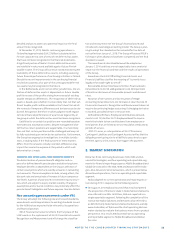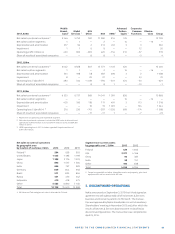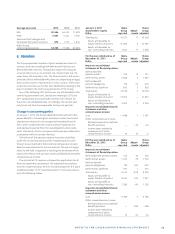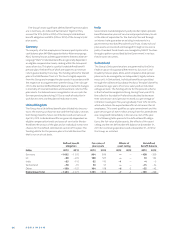Nokia 2013 Annual Report Download - page 36
Download and view the complete annual report
Please find page 36 of the 2013 Nokia annual report below. You can navigate through the pages in the report by either clicking on the pages listed below, or by using the keyword search tool below to find specific information within the annual report.NOKIA IN 2013
34
quently at amortized cost less impairment using the eff ective
interest method. Loans are subject to regular and thorough
review as to their collectability and available collateral. In the
event that a loan is deemed not fully recoverable, a provision is
made to refl ect the shortfall between the carrying amount and
the present value of the expected cash fl ows. Loan interest is
recognized in interest income. The long-term portion of loans
receivable is included on the consolidated statement of fi nan-
cial position under long-term loans receivable and the current
portion under current portion of long-term loans receivable.
BANK AND CASH
Bank and cash consist of cash at bank and in hand.
ACCOUNTS RECEIVABLE
Accounts receivable are carried at the original amount due
from customers less allowances for doubtful accounts, which
is considered to be fair value. Allowances for doubtful accounts
are based on a monthly review of all outstanding amounts
where signifi cant doubt about collectability exists. Monthly
review includes an analysis of historical bad debt, customer
concentrations, customer creditworthiness, current economic
trends and changes in our customer payment terms. Allowance
for doubtful accounts is included in other operating expenses.
Financial liabilities
COMPOUND FINANCIAL INSTRUMENTS
Compound fi nancial instruments have both a fi nancial liability
and an equity component from the issuers’ perspective. The
components are defi ned based on the terms of the fi nancial
instrument and presented and measured separately accord-
ing to their substance. At initial recognition of a compound
fi nancial instrument, the fi nancial liability component is
recognized at fair value and residual amount is allocated to the
equity component. This allocation is not revised subsequently.
The Group has issued convertible bonds, which are compound
fi nancial instruments, and their fi nancial liability component is
accounted for as a loan payable.
LOANS PAYABLE
Loans payable are recognized initially at fair value, net of
transaction costs incurred. In subsequent periods loans
payable are measured at amortized cost using the eff ective
interest method. Transaction costs and loan interest are rec-
ognized in fi nancial income and expenses over the life of the
instrument. The long-term portion of loans payable is included
on the consolidated statement of fi nancial position under
long-term interest-bearing liabilities and the current portion
under current portion of long-term loans.
ACCOUNTS PAYABLE
Accounts payable are carried at the original invoiced amount,
which is considered to be fair value due to the short-term
nature of the Group’s accounts payable.
Derivative fi nancial instruments
All derivatives are initially recognized at fair value on the date
a derivative contract is entered into and are subsequently
remeasured at their fair value. The method of recognizing the
resulting gain or loss varies according to whether the derivatives
are designated under and qualify for hedge accounting or not.
Generally, the cash fl ows of a hedge are classifi ed as cash
fl ows from operating activities in the consolidated state-
ments of cash fl ows as the underlying hedged items relate to
the Group’s operating activities. When a derivative contract is
accounted for as a hedge of an identifi able position relating to
fi nancing or investing activities, the cash fl ows of the contract
are classifi ed in the same manner as the cash fl ows of the
position being hedged.
DERIVATIVES NOT DESIGNATED IN HEDGE ACCOUNTING
RELATIONSHIPS CARRIED AT FAIR VALUE THROUGH PROFIT
AND LOSS
Forward foreign exchange contracts are valued at the market
forward exchange rates. Changes in fair value are measured by
comparing these rates with the original contract forward rate.
Currency options are valued at each balance sheet date by us-
ing the Garman & Kohlhagen option valuation model. Changes
in the fair value on these instruments are recognized in profi t
and loss.
Fair values of forward rate agreements, interest rate op-
tions, futures contracts and exchange traded options are cal-
culated based on quoted market rates at each balance sheet
date. Discounted cash fl ow analyses are used to value interest
rate and cross-currency interest rate swaps. Changes in the
fair value of these contracts are recognized in profi t and loss.
For derivatives not designated under hedge accounting but
hedging identifi able exposures such as anticipated foreign
currency denominated sales and purchases, the gains and
losses are recognized in other operating income or expenses.
The gains and losses on all other derivatives are recognized in
fi nancial income and expenses.
Embedded derivatives are identifi ed and monitored by the
Group. Embedded derivatives are measured at fair value at
each balance sheet date with changes in the fair value recog-
nized in profi t and loss.
Hedge accounting
The Group applies hedge accounting on certain forward foreign
exchange contracts, certain options or option strategies and
certain interest rate derivatives. Qualifying options and option
strategies have zero net premium or a net premium paid. For
option structures the critical terms of the bought and sold op-
tions are the same and the nominal amount of the sold option
component is no greater than that of the bought option.
CASH FLOW HEDGES: HEDGING OF FORECAST FOREIGN
CURRENCY DENOMINATED SALES AND PURCHASES
The Group applies hedge accounting for “Qualifying hedges”.
Qualifying hedges are those properly documented cash fl ow




